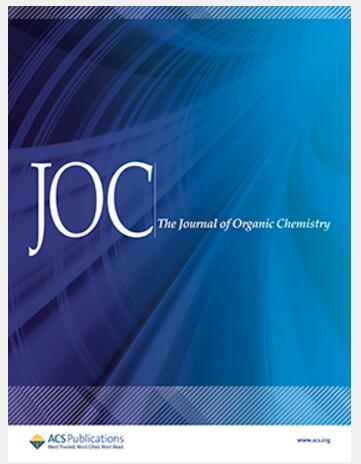用吖啶-路易斯酸光催化剂进行芳基卤化物和三氟酸盐的可见光SNAr吡啶化。
IF 3.3
2区 化学
Q1 CHEMISTRY, ORGANIC
引用次数: 0
摘要
本文介绍了一种采用模块化吖啶-路易斯酸光催化剂进行芳基(伪)卤化物阳离子自由基加速(CRA) SNAr吡啶化的可见光(440 nm)光催化方法。由吖啶和Sc(OTf)3组成的第一代催化剂对电子多样性吡啶与富电子(主要是烷氧基和烷基取代)芳酰氯和三氟酸盐的反应有效。对于选择的底物对,另一种电子给体-受体途径也可以起作用。改性原位光催化剂的吖啶主链拓宽了芳酰氯偶联伙伴的范围,实现了以未活化的氯苯衍生物为限制试剂的可见光CRA-SNAr。本文章由计算机程序翻译,如有差异,请以英文原文为准。
Visible-Light SNAr Pyridination of Aryl Halides and Triflates with Acridine-Lewis Acid Photocatalysts.
This report describes the development of a visible light (440 nm) photocatalytic method for the cation radical-accelerated (CRA) SNAr pyridination of aryl (pseudo)halides using modular acridine-Lewis acid photocatalysts. A first-generation catalyst composed of acridine and Sc(OTf)3 is effective for the reaction of electronically diverse pyridines with electron-rich (primarily alkoxy- and alkyl-substituted) aryl chlorides and triflates. With select substrate pairs, an alternative electron donor-acceptor pathway can also be operative. Modifying the acridine backbone of the in situ photocatalyst broadens the scope of aryl chloride coupling partners, enabling visible light CRA-SNAr with unactivated chlorobenzene derivatives as the limiting reagent.
求助全文
通过发布文献求助,成功后即可免费获取论文全文。
去求助
来源期刊

Journal of Organic Chemistry
化学-有机化学
CiteScore
6.20
自引率
11.10%
发文量
1467
审稿时长
2 months
期刊介绍:
Journal of Organic Chemistry welcomes original contributions of fundamental research in all branches of the theory and practice of organic chemistry. In selecting manuscripts for publication, the editors place emphasis on the quality and novelty of the work, as well as the breadth of interest to the organic chemistry community.
 求助内容:
求助内容: 应助结果提醒方式:
应助结果提醒方式:


